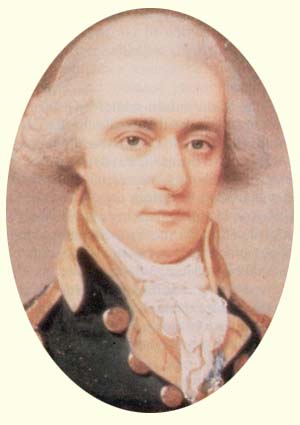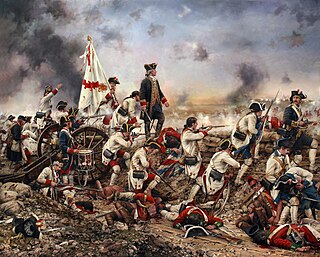
The American Revolutionary War, also known as the Revolutionary War or American War of Independence, was an armed conflict that was part of the broader American Revolution, in which American Patriot forces organized as the Continental Army and commanded by George Washington defeated the British Army.

Richard Dale was an American naval officer who fought in the Continental Navy under John Barry and was first lieutenant for John Paul Jones during the naval battle off of Flamborough Head, England against HMS Serapis in the celebrated engagement of September 23, 1779. He became one of the six original commodores of the permanent United States Navy, and commanded a blockade of Tripoli in 1801 during the First Barbary War of Thomas Jefferson's presidency.

Bernardo Vicente de Gálvez y Madrid, 1st Count of Gálvez was a Spanish military leader and government official who served as colonial governor of Spanish Louisiana and Cuba, and later as Viceroy of New Spain.

The Penobscot Expedition was a 44-ship American naval armada during the Revolutionary War assembled by the Provincial Congress of the Province of Massachusetts Bay. The flotilla of 19 warships and 25 support vessels sailed from Boston on July 19, 1779, for the upper Penobscot Bay in the District of Maine carrying an expeditionary force of more than 1,000 American colonial marines and militiamen. Also included was a 100-man artillery detachment under the command of Lt. Colonel Paul Revere.

The siege of Pensacola, fought from March 9 to May 10, 1781, was the culmination of Spain's conquest of West Florida during the Gulf Coast Campaign of the American Revolutionary War.

The Battle of Baton Rouge was a brief siege during the Anglo-Spanish War that was decided on September 21, 1779. Fort New Richmond was the second British outpost to fall to Spanish arms during Bernardo de Gálvez's march into West Florida.

The Battle of Fort Charlotte, also known as the Siege of Fort Charlotte, was a two-week siege conducted by Spanish general Bernardo de Gálvez against the British fortifications guarding the port of Mobile, during the Anglo-Spanish War of 1779-1783. Fort Charlotte was the last remaining British frontier post capable of threatening New Orleans, Louisiana. Its fall drove the British from the western reaches of West Florida and reduced the British military presence in West Florida to its capital, Pensacola.
Oliver Pollock was a merchant and financier of the American Revolutionary War, of which he has long been considered a historically undervalued figure. He is often credited with inventing the U.S. Dollar sign in 1778.

William Jackson was a figure in the American Revolution and one of the Founding Fathers of the United States. He served as secretary to the 1787 United States Constitutional Convention, and as part of his duties added his signature to the United States Constitution. He also served with distinction in the Continental Army during the Revolutionary War. After the war, he served as one of President George Washington's personal secretaries.

Spain, through its alliance with France and as part of its conflict with Britain, played a role in the independence of the United States. Spain declared war on Britain as an ally of France, itself an ally of the American colonies. Most notably, Spanish forces attacked British positions in the south and captured West Florida from Britain in the siege of Pensacola. This secured the southern route for supplies and closed off the possibility of any British offensive through the western frontier of the United States via the Mississippi River. Spain also provided money, supplies, and munitions to the American forces.
USS Morris was a schooner in the Continental Navy placed in commission in 1779. She was named for Founding Father, Continental Congressman, and a major financier of the American Revolutionary War, Robert Morris.

The Battle of Lake Pontchartrain was a single-ship action on September 10, 1779, part of the Anglo-Spanish War. It was fought between the British sloop-of-war HMS West Florida and the Continental Navy schooner USS Morris in the waters of Lake Pontchartrain, then in the British province of West Florida.

The Capture of the Bahamas took place in May 1782 during the American Revolutionary War when a Spanish force under the command of Juan Manuel Cagigal arrived on the island of New Providence near Nassau, the capital of the Bahamas. The British commander at Nassau, John Maxwell decided to surrender the island without a fight when confronted by the superior force.

General John Campbell, 17th Chief of MacArthur Campbells of Strachur was a Scottish soldier and nobleman, who commanded the British forces at the Siege of Pensacola, and succeeded Guy Carleton, 1st Baron Dorchester as Commander-in-Chief in North America in 1783 following the end of the American War of Independence.

Lachlan McIntosh was a Scottish American military and political leader during the American Revolution and the early United States. In a 1777 duel, he fatally shot Button Gwinnett, a signer of the Declaration of Independence ten months earlier.
Gálveztown, originally HMS West Florida, was a two–masted brigantine which the Continental Navy schooner USS Morris captured at the Battle of Lake Pontchartrain, which was then in the British province of West Florida. West Florida became Gálveztown, supposedly under the command of Bernardo de Gálvez, the Spanish governor of Louisiana.

The British Army during the American Revolutionary War served for eight years in the American Revolutionary War, which was fought throughout North America, the Caribbean, and elsewhere from April 19, 1775, to September 3, 1783. The war formally commenced at the Battles of Lexington and Concord in present-day Massachusetts. Two months later, in June 1775, the Second Continental Congress, gathered in the revolutionary capital of Philadelphia, appointed George Washington to organize patriot militias into the Continental Army and lead them in a war against the British Army. The following year, in July 1776, the Second Continental Congress, representing the Thirteen Colonies, declared themselves free and independent from colonial governance.

The Anglo-French War, also known as the War of 1778 or the Bourbon War in Britain, was a military conflict fought between France and Great Britain, sometimes with their respective allies, between 1778 and 1783. As a consequence, Great Britain was forced to divert resources used to fight the American War of Independence to theatres in Europe, India, and the West Indies, and to rely on what turned out to be the chimera of Loyalist support in its North American operations. From 1778 to 1783, with or without their allies, France and Britain fought over dominance in the English Channel, the Mediterranean, the Indian Ocean and the Caribbean.
James Willing (1750–1801) was a representative of the American Continental Congress who led a 1778 military expedition during the American Revolutionary War. Known as the Willing Expedition, the effort involved raiding British forts, plantations, and other properties of loyalists in the colonial British West Florida settlement of Natchez. Later that year, he sought protection from the British by hiding out in New Orleans, but was taken prisoner by them on his attempt to return to Philadelphia.